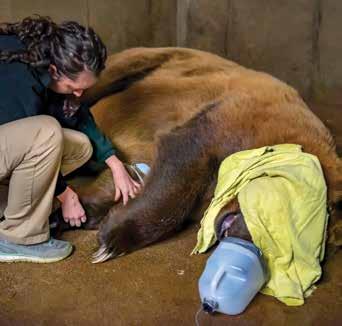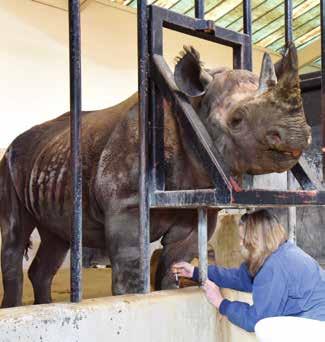
5 minute read
Animal Medicine: Vets treat all shapes & sizes
MAKING THE MEDICINE GO DOWN


A doctor has a lot to think about when writing a prescription: What’s the best medication to treat this problem? What is the proper dosage? How is the medicine best administered? Now imagine that doctor is dealing with patients ranging in size from 10,000 pounds to just a few ounces, with wildly different body systems, none of whom can tell you what’s wrong or how the medicine is working. Welcome to the world of zoo medicine, where treatment is rarely simple. Dr. Vickie Clyde, Milwaukee County Zoo senior staff veterinarian, and the staff at the Animal Health Center care for more than 2,000 animals at the Zoo representing 354 species, from fish to armadillos to elephants. Although animal medicine has advanced in Clyde’s 30-year career, “we remain with the dilemma of how you treat a wild animal, sometimes a species for which there isn’t any medical data or there’s limited medical data.”
When an animal is sick, the veterinary staff has many resources to find an effective treatment. Dosages for different zoo species are published in zoo textbooks and journal articles that can be searched online. Zoos share information among themselves about what has worked in the past. Sometimes veterinarians consult with medical doctors, particularly when working with primates, which are genetically close to humans. Other times, they work with domesticanimal veterinarians. “I say ‘Just tell me how to approach this problem in the species that you’re used to dealing with,’ and then we make a plan of how we can apply that to our animals,” Clyde says.
Once a medication is identified, the staff has to figure out how to get it into the animal. That’s where a compounding pharmacy such as The Pet Apothecary can come in. Jeff and Patti Langer had already been working with the Zoo for several years at their traditional pharmacy when they sold that pharmacy and opened The Pet Apothecary in 1999. It’s a compounding pharmacy, meaning it custom-makes each medication to order. “The Zoo offers us the most challenges because they have so many species and so many nuances to the species and the diets,” Jeff Langer says.
The Pet Apothecary’s most active “clients” from the Zoo are the Humboldt penguins, who must be preventatively Dr. Vickie Clyde Photo by Richard Brodzeller
The Zoo tries to avoid anesthetizing animals when possible, but sometimes it’s necessary, as in this checkup for a grizzly bear. Anesthesia drugs have come a long way in recent decades, according to Dr. Vickie Clyde, Zoo senior staff veterinarian. Photo by Joel Miller Pharmacist Jeff Langer has been preparing medications for the Zoo for more than two decades, first through his traditional pharmacy and later as the founder of The Pet Apothecary in Milwaukee. Photo submitted by The Pet Apothecary
treated for avian malaria. They take a capsule with three medications in it every other day from around May 1 to the first frost. The capsules are inserted into fish to get the penguins to eat them. The Pet Apothecary has added other flavors for different species depending on the animals’ tastes. “We provide a wide variety of flavors from fruits to meats, marshmallow to peanut butter,” Langer says.
“Then there are drugs that no matter how you flavor it, they’re not going to taste good,” Clyde says. She remembers treating an orangutan that refused to take medication for pneumonia. “When I tasted it, I almost gagged and was nauseous for six hours. If I couldn’t handle that little bit, how could I expect the orangutan to take it?” A different drug in the same treatment category was less bitter and could be flavored so the orangutan was willing to take it.
Medication can be administered in a variety of ways, depending on the species. For example, amphibians such as frogs have semipermeable skin, so keepers can put the medication in their water or apply it to their skin, says Dr. Roberta Wallace, who retired last year as the Zoo’s senior staff veterinarian. However, that method is not as sure-fire as injection because you have little control over how much medication is absorbed.
Large animals present a special challenge. A hippo at the Zoo once developed skin lesions and needed a topical solution on its back, Wallace says. “Of course the keepers can’t go in with the animal, and it was too far away for them to reach by hand, so they fashioned a paintbrush on the end of a stick and were able to lean over from above and paint the medication on top of the hippo’s wounds.” In other cases, staff uses an air gun to shoot a dart that injects the medication into the animal. This is especially helpful with hoofed animals. Whenever possible, the veterinarian selects a long-acting drug to avoid having to dart the patient daily, since being darted can stress the animal, which could weaken its immune system. Of course, formulating medicine for very small animals is also difficult, Langer says. He sometimes has to create extremely concentrated medications for the smallest Zoo animals, which can make it hard to know how long the medication will last or how it will affect the animal. Early in his relationship with the Zoo, he helped treat a fruit bat for heart disease. “They were going to great lengths to find a way to get the heart medication into a one-drop dose that they could administer to a bat.” It’s that kind of dedication that makes him proud to work with the Zoo. “It’s amazing that they take the time with every snake and every bat and every bird that goes in there. It’s truly been an honor to work with the Zoo for all these years.”
By Stacy Vogel Davis Keepers hide anti-malaria medication in the penguins’ fish every other day. Photo by Richard Brodzeller Many Zoo animals are trained to allow injections for medications or blood draws without the use of anesthesia. Photo by Joel Miller









